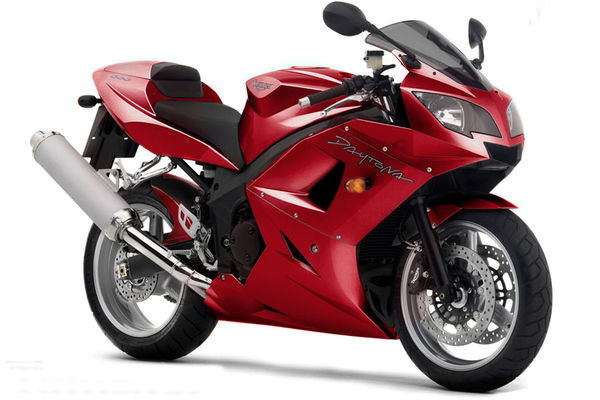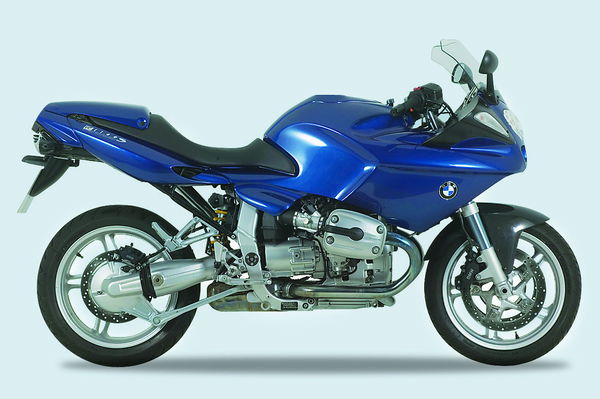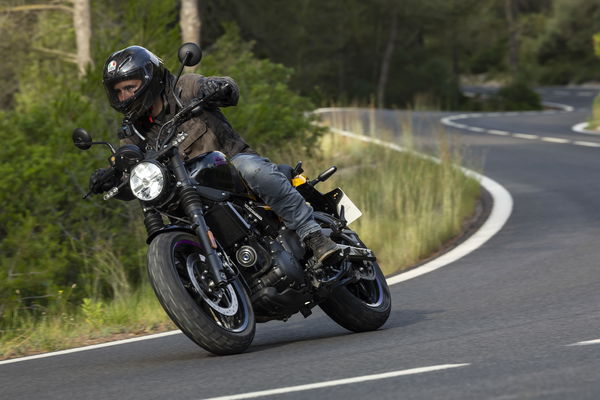Daytona 600 (2003 - 2005) review
We have the real deal from Britain to match the Japs with the Daytona. Going racing for the first time in three decades has underlined the confidence Triumph has in its 600.

Mystic Mac is the name and looking into the future is the game, so I knew five days before I travelled to Cartagena for the Daytona 600 launch that Triumph had built a new supersports bike that could take on the latest offerings from Japan and Italy. Okay, this time it wasn’t my crystal balls that had enlightened me but the first round of the British Supersports Championship at Silverstone.
On its race debut, and with very little testing, Craig Jones and Jim Moodie finished 9th and 13th respectively on the Daytona after mixing it with some serious competition on new generations 600s. With handling and performance still to improve I’d put my money on rostrum positions very soon.
So, on to the standard road bike, is it really as good as the new CBR, R6, ZX-6R and 749? On track and road the Honda has been unanimously voted the overall winner, but that was before the Triumph. How does the Daytona shape up against the opposition? Well I can’t honestly answer that until we back to back ‘em, which shows how good the Triumph is, but here’s what I found after my first skid round in Spain.
I slipped into the world of journalism just after Triumph had sorted out its fuel injection gremlins on the original TT600 and I can honestly say I have never ridden a bad TT, either on the road or track. The engine revved hard, sounded sweet and 140mph+ was easily seen on the speedo. But it seems as though I was in the minority and was frequently told by fellow hacks that I had had too many bumps on the head while racing. They may well be right, but I think it was that all important first impression when the TT had the bottom end flat spot problem that prevented any future praise for the Hinckley 600.
So when Triumph announced that the Daytona engine is based around a heavily modified TT600 motor there were a few under-breath comments about fuelling glitches and flat spots. Well I didn’t find any. The powerband is very linear, pulling nicely from 9000rpm then a final smooth surge from 12,000 to 14,000 and shifting just after 14,200 with the rev limiter cutting in at 15,000rpm. This has been made possible by the new Keihin twin butterfly injection system.
Throttle feeling mid-corner is faultless and playing with the new shorter travel throttle at any rpm isn’t a problem. I’d say the Honda pulled stronger, but only slightly from what I can remember with a tad more top end, while the Yamaha is weaker in the middle but stronger on top – especially at speed with the effective ram air induction. The engine sound isn’t as peaky as the R6 but there is a definite familiar throaty Triumph growl. Claimed maximum power is 112bhp at the crank although I’d imagine this figure would be higher at speed and with the ram air effect. It’s definitely a more realistic figure than the frankly ridiculous claims of the Japanese manufacturers.
Great stuff, and so far so good. But it’s not all plain sailing for the Daytona when it comes to the motor, because the gearbox could do with some attention. The operation is okay but it seems to have more travel and is stiffer than the other Japanese bikes. It works fine but you have to be positive and changing gear takes more time, albeit 10ths of a second, but it’s noticeable. I reckon it could be that the solid gear lever moves away from your foot – the race team uses a linkage system which makes the lever move vertically, a better option. I tried a few bikes on the launch and some were better than others. I asked the Triumph technicians and was told that some of the bikes were pre-production models and this may not have helped, also I was informed things loosen up after running in. Time will tell.
When TWO tested the latest Japanese sports 600s on track earlier this year Honda’s new CBR RR emerged as having the best chassis. Although compared to the Honda the Daytona is physically bigger, it matches the Honda’s nimble handling and if anything the front end is even more planted, inspiring greater confidence. Direction change is plenty quick enough and stability while accelerating over bumps and at high speed was rock solid. Even on the bumpy and twisty road ride down to the Spanish Coast I tried everything I knew to upset the front and make the Daytona tank slap without success. I feel this is one of the best features of the Triumph as there is no need for a steering damper (saves money) plus the safety factor on unpredictable terrain is excellent. The front and rear weight balance seems spot on and combined with 24.6 degree head angle gives great rider confidence.
In fact the chassis was so good and gave so much feedback the only way I could get the rear to step out was mid-corner and on the absolute edge of the tyre, and only because I was pushing to the very limit of adhesion. The Pirelli Diablos the Daytona comes with as standard are especially developed for the bike and they work brilliantly.
Another impressive feature are the front brakes. The 308mm discs give great initial feel with the very stable 43mm cartridge front fork/Pirelli combination allowing you to use more than enough braking force as and when necessary. The rear brake was okay the few times I used it.
Although the tank looks quite bulky, and feels quite wide while riding, it’s necessary to look in keeping with the rest of the bike and isn’t a problem. The riding position is much more race-like compared to the TT, but is comfy on the track and road with the seat sloping up away from the tank.
The controls and dash are fairly standard, a digital speedo and black analogue rev counter, looking a bit like a phone for the elderly – easy to read with big numbers, but a bit boring on the eye. The only noticeable thing notable by its absence is a shift light, which has suddenly become the norm on sports bikes.
Mystic Mac is the name and looking into the future is the game, so I knew five days before I travelled to Cartagena for the Daytona 600 launch that Triumph had built a new supersports bike that could take on the latest offerings from Japan and Italy. Okay, this time it wasn’t my crystal balls that had enlightened me but the first round of the British Supersports Championship at Silverstone.
On its race debut, and with very little testing, Craig Jones and Jim Moodie finished 9th and 13th respectively on the Daytona after mixing it with some serious competition on new generations 600s. With handling and performance still to improve I’d put my money on rostrum positions very soon.
So, on to the standard road bike, is it really as good as the new CBR, R6, ZX-6R and 749? On track and road the Honda has been unanimously voted the overall winner, but that was before the Triumph. How does the Daytona shape up against the opposition? Well I can’t honestly answer that until we back to back ‘em, which shows how good the Triumph is, but here’s what I found after my first skid round in Spain.
I slipped into the world of journalism just after Triumph had sorted out its fuel injection gremlins on the original TT600 and I can honestly say I have never ridden a bad TT, either on the road or track. The engine revved hard, sounded sweet and 140mph+ was easily seen on the speedo. But it seems as though I was in the minority and was frequently told by fellow hacks that I had had too many bumps on the head while racing. They may well be right, but I think it was that all important first impression when the TT had the bottom end flat spot problem that prevented any future praise for the Hinckley 600.
So when Triumph announced that the Daytona engine is based around a heavily modified TT600 motor there were a few under-breath comments about fuelling glitches and flat spots. Well I didn’t find any. The powerband is very linear, pulling nicely from 9000rpm then a final smooth surge from 12,000 to 14,000 and shifting just after 14,200 with the rev limiter cutting in at 15,000rpm. This has been made possible by the new Keihin twin butterfly injection system.
Throttle feeling mid-corner is faultless and playing with the new shorter travel throttle at any rpm isn’t a problem. I’d say the Honda pulled stronger, but only slightly from what I can remember with a tad more top end, while the Yamaha is weaker in the middle but stronger on top – especially at speed with the effective ram air induction. The engine sound isn’t as peaky as the R6 but there is a definite familiar throaty Triumph growl. Claimed maximum power is 112bhp at the crank although I’d imagine this figure would be higher at speed and with the ram air effect. It’s definitely a more realistic figure than the frankly ridiculous claims of the Japanese manufacturers.
Great stuff, and so far so good. But it’s not all plain sailing for the Daytona when it comes to the motor, because the gearbox could do with some attention. The operation is okay but it seems to have more travel and is stiffer than the other Japanese bikes. It works fine but you have to be positive and changing gear takes more time, albeit 10ths of a second, but it’s noticeable. I reckon it could be that the solid gear lever moves away from your foot – the race team uses a linkage system which makes the lever move vertically, a better option. I tried a few bikes on the launch and some were better than others. I asked the Triumph technicians and was told that some of the bikes were pre-production models and this may not have helped, also I was informed things loosen up after running in. Time will tell.
When TWO tested the latest Japanese sports 600s on track earlier this year Honda’s new CBR RR emerged as having the best chassis. Although compared to the Honda the Daytona is physically bigger, it matches the Honda’s nimble handling and if anything the front end is even more planted, inspiring greater confidence. Direction change is plenty quick enough and stability while accelerating over bumps and at high speed was rock solid. Even on the bumpy and twisty road ride down to the Spanish Coast I tried everything I knew to upset the front and make the Daytona tank slap without success. I feel this is one of the best features of the Triumph as there is no need for a steering damper (saves money) plus the safety factor on unpredictable terrain is excellent. The front and rear weight balance seems spot on and combined with 24.6 degree head angle gives great rider confidence.
In fact the chassis was so good and gave so much feedback the only way I could get the rear to step out was mid-corner and on the absolute edge of the tyre, and only because I was pushing to the very limit of adhesion. The Pirelli Diablos the Daytona comes with as standard are especially developed for the bike and they work brilliantly.
Another impressive feature are the front brakes. The 308mm discs give great initial feel with the very stable 43mm cartridge front fork/Pirelli combination allowing you to use more than enough braking force as and when necessary. The rear brake was okay the few times I used it.
Although the tank looks quite bulky, and feels quite wide while riding, it’s necessary to look in keeping with the rest of the bike and isn’t a problem. The riding position is much more race-like compared to the TT, but is comfy on the track and road with the seat sloping up away from the tank.
The controls and dash are fairly standard, a digital speedo and black analogue rev counter, looking a bit like a phone for the elderly – easy to read with big numbers, but a bit boring on the eye. The only noticeable thing notable by its absence is a shift light, which has suddenly become the norm on sports bikes.
Length (mm)2050
Width (mm)660
Height (mm)1135
Dryweight (kg)165
Seat Height (mm)815
Suspension Front-43mm cartridge forks.adjustable preload, compression and rebound damping
Suspension Rear-Monoshock adjustable preload, compression and rebound damping
Adjustability Front-Adjustable preload, compression and rebound damping
Adjustability Rear-Adjustable preload, compression and rebound damping
Wheels Front-17 x 3.5in Wheels Rear-17 x 5.5in Wheels- Made OfAlloy
Tyres Front120/70 ZR17 Tyres Rear180/55 ZR17
Brakes Front-Twin 308mm floating discs, 4 piston calipers
Brakes Rear-Single 220mm disc, single piston caliper
Tank Capacity (litres)18
Wheelbase (mm)1390
Rake (degrees)24.6
Trail (mm)89
Chassis-Aluminium beam perimeter
Cubic Capacity (cc)599
Max Power (bhp)110
Max Power Peak (rpm)12750
Torque (ft/lb)51
Torque Peak (rpm)11000
Bore (mm)68
Stroke (mm)41.3
Valve Gear-DOHC Compression Ratio12.5
IgnitionDigital - inductive type
Cooling-Liquid cooled
Fuel DeliveryTwin-butterfly
Stroke Type-Four Stroke
Drive-Chain
Top Speed154.3











